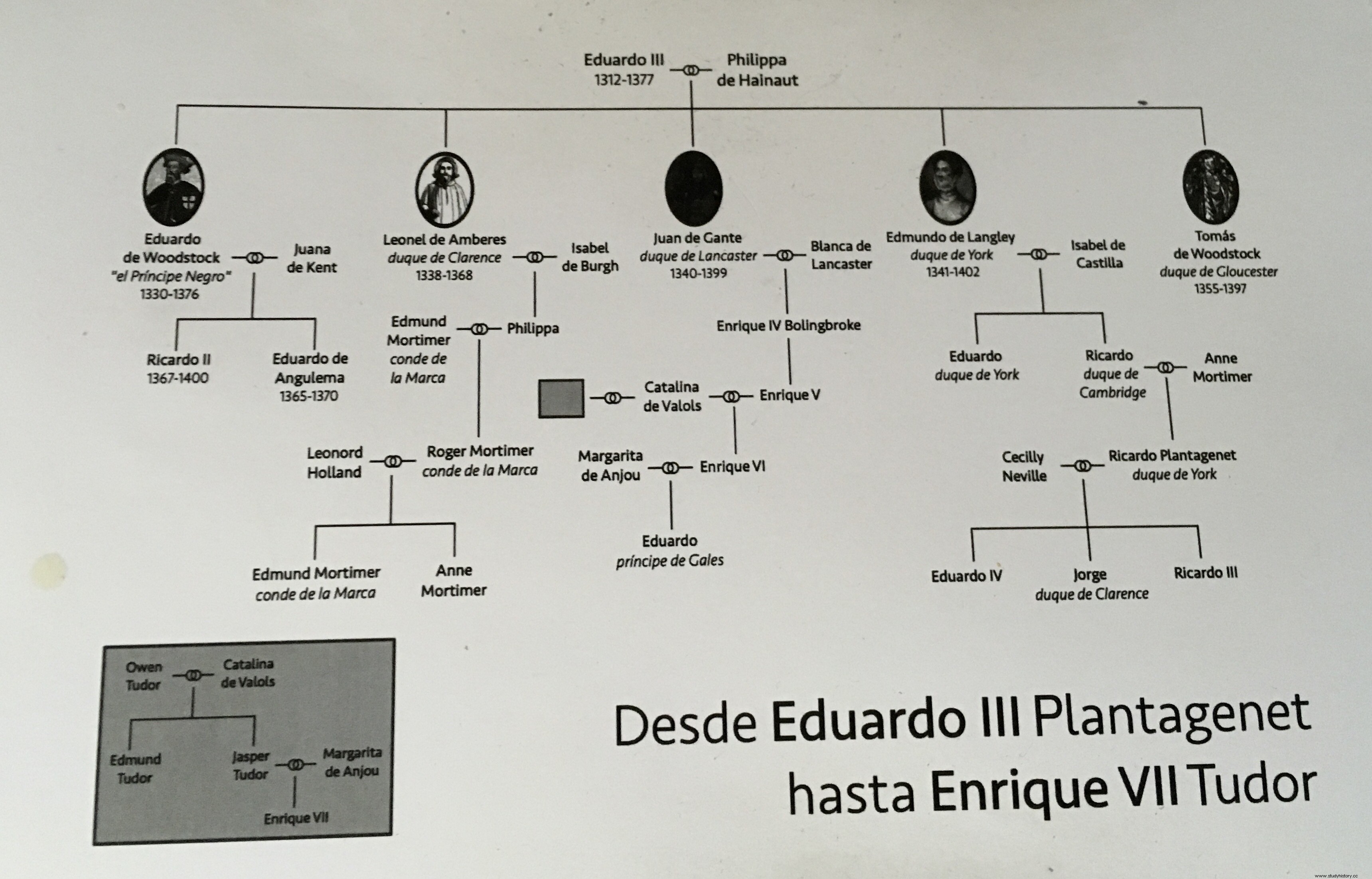IV.- 1461. The War of the Roses:Henry VI against Edward IV
Although the Wars of the Roses began in 1455, it is not possible to understand this dynastic conflict without the facts described in the previous entry about the succession of Edward III and the deposition of Richard II by Henry Bolinbroke.
The coronation of Enrique IV supposed the ascent to the throne of the descendants of the third son of Eduardo III, Juan de Gante. This branch is known as the House of Lancaster and continued to rule when Henry V came to the throne.
Meanwhile, the offspring of his second and fourth children, Leonel of Antwerp, Duke of Clarence, and Edmund Langley, Duke of York, had been united into one with the marriage of two of their descendants, Anne Mortimer on Clarence's side. and Ricardo de Conisburgh, by York (see family tree). Since 1415 the title of Duke of York had passed to their son, Richard Plantagenet. His supporters argued that since Richard II had died without issue and the line of Edward III's first son had become extinct, the crown should have passed to the hereditary line of Leonel of Antwerp, his second son, and not to that of his third son. scion John of Ghent.

After the premature death of Henry V in 1422, the leadership of the Lancastrians went from being represented by the new winner of Agincourt to the hands of his one-year-old son, Henry VI, who, over time, proved that he was not up to the task. his father.
Thus we arrive at 1453, a difficult year for England. In France, after the Battle of Castillon, only Calais remained in English hands. And in August the king suffered a strange stroke that left him unable to speak or even walk. The members of the Royal Council turned their eyes on Richard Plantagenet, Duke of York. He was appointed Protector and Defender of the Kingdom and the Church by the Parliament, although he made it clear that he did so only under the obligation of the circumstances and for the time strictly necessary.
When at the end of 1454 Henry VI came to his senses he undid everything agreed upon during his illness and summoned the Duke of York to a council in Leicester in April 1455 where he would be asked to account for his actions as Protector of the Realm. . Unwilling to be judged, Ricardo reacted by arming himself to defend himself:the War of the Roses was served.
It is not the purpose of this article to narrate the multiple dimes and diretes of this conflict, but to focus on the episodes during it in which the Crown changed hands as a result of an invasion from the continent.

Richard Plantagenet died at the Battle of Wakefield in December 1460. His title and claim to the throne passed to his eldest son, Edward, who won a decisive victory at the Battle of Towton in 1461, considered the bloodiest ever fought on English soil. . He was crowned King of England under the name of Edward IV. His main ally to the throne was Richard Neville, Earl of Warwick, who became known as The Kingmaker . Warwick wanted to take advantage of the fact that the king was the most sought-after bachelor in Europe to find a marriage alliance that would suit the international interests of the kingdom and that would also establish him as an essential piece of power in England.
But Eduardo IV was not convinced. His growing differences with Warwick over foreign and dynastic policy erupted when he secretly married Elizabeth Woodville, widow of a Lancastrian nobleman. This marriage shattered Warwick's negotiations for a strategically essential marriage for England. In addition, the new queen belonged to a large family that she was gradually placing in decisive positions in the Government and arranging advantageous marriages for them, thus displacing other ancient families of the nobility and undermining the influence of the Earl of Warwick. To finish breaking the relationship between the king and the one who had been his main supporter, while Warwick was looking for an alliance with France, the family of Isabel Woodville had important family relations with Burgundy, with whom Edward IV signed a commercial agreement that was also reflected at his sister's wedding to the Duke of Burgundy.
Warwick's reaction was to turn his back on Edward IV and ally himself with the king's wayward brother, George, Duke of Clarence (to whom he granted his daughter's hand) and the Lancastrian party.
In the summer of 1469 a popular rebellion broke out in the north of the country whose leader called himself Robin of Redesdale, although it is suspected that behind this alias was Sir John Conyers, cousin of the Earl of Warwick. He issued a proclamation from Calais, where he was, declaring that for the good of the kingdom he was joining this rebellion against the king's evil advisers.
Warwick landed in England and commanded a sizeable army. They defeated the monarch at the Battle of Edgecote in 1469 and even took him prisoner at Warwick Castle. There was a paralysis of the political situation, because Warwick was in no condition to govern with Edward IV imprisoned in his castle and the royal council against him. Eduardo was released between protests of friendship with Warwick and his brother and the request for royal pardon from them. But soon after, both tried to organize another rebellion with disastrous results and were forced to flee to France.
However, the Earl of Warwick did not give up. With the help of the King of France he made peace and allied himself with Henry VI's wife, Margaret of Anjou. In September 1470 they landed in Devon and moved rapidly westward, winning converts as they went. Eduardo, lost London, impoverished and without support, was forced to flee to Holland and from there to Burgundy, where the usefulness of having arranged the marriage of his sister with the duke of the region was proven. The Warwick and Lancaster party put Henry VI back on the throne, even though he was The Kingmaker who ruled.
But the story didn't end here either. Edward IV returned from exile with the financial support of the Duke of Burgundy. Clarence left Warwick and returned to his brother. On April 14, 1471, Edward met and defeated Richard Neville at Barnet, who died in battle. He then set out to deal with Margaret of Anjou and her son Edward, who had landed in England unaware of Warwick's death. The two armies met at Tewkesbury on May 4, 1471. Edward IV was victorious and the Prince of Wales was executed. Only ten days later, Henry VI died, most likely assassinated, in the Tower of London.

Nor would this be the end of the Wars of the Roses... as we will see in the next and last entry on the other invasions of England.
